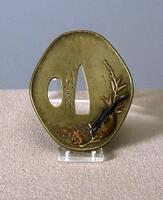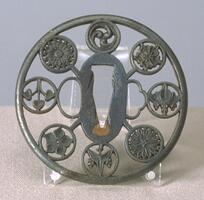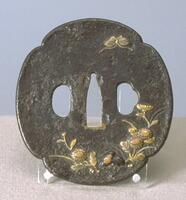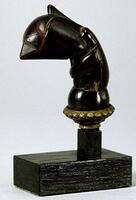11 UMMA Objects
11 UMMA Objects

Indonesian
Kris handle in the shape of an ogre
20th century
Gift of Mary T. LaMore in memory of Chet LaMore
1981/2.77

Japanese (Japanese (culture or style))
Tsuba (sword guard) with design of Kanzan (Chinese, Han Shan) and Jittoku (Chinese, Shihde), two Zen eccentrics
1700 – 1732
Gift of Mr. and Mrs. Robert T. Weston
1978/2.5

Kagemitsu
Sword (13th century) and scabbard (18th century) with design of samurai writing a poem under cherry tree
1299 – 1301
Gift of Mr. and Mrs. Frederic R. Smith
1973/2.85

Kinai School
Tsuba (sword guard) with design of three pawlownia crests and vines
1745 – 1755
Gift of Mr. and Mrs. Robert T. Weston
1978/2.4

Seishinsai
Tsuba (sword guard) with design of blowfish, shrimp and plant
19th century
Gift of Mr. and Mrs. Robert T. Weston
1978/2.3

Okada Masatoyo
Tsuba (Sword guard) with design of dragon among clouds
19th century
Gift of Mr. and Mrs. Robert T. Weston
1978/2.6

Japanese (Japanese (culture or style))
Tsuba (sword guard) with eight family crests
19th century
Gift of Mr. and Mrs. Robert T. Weston
1978/2.7

Japanese (Japanese (culture or style))
Tsuba (sword guard) with chrysanthemum and butterfly design
18th century
Gift of Mr. and Mrs. Robert T. Weston
1978/2.11

Ietsugu
Sword (original) and later handle, sword guard, and scabbard
1394 – 1427
Gift of Mr. and Mrs. Frederic R. Smith
1973/2.87

Artist Unknown, Nabeshima ware, Japan
Tsuba (sword guard) with incised flame design
1567 – 1632
Museum purchase made possible by the Margaret Watson Parker Art Collection Fund
1966/1.101
Loading…

